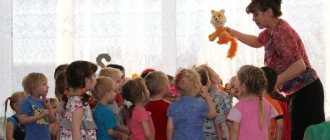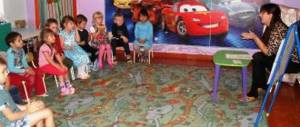Types and forms of theatrical games in the first junior group of preschool educational institutions
Theatrical games are divided into 2 groups:
- those in which children are organized by adults and act as artists in images using verbal and non-verbal methods of expression, that is, dramatization;
- those in which the children themselves are the organizers of toys and dolls to create a conditional situation, that is, director's games.
Playing with finger puppets develops fine motor skills
Table: types of dramatizations and director's games in the first junior group
| Game group | View | Description |
| Dramatization | Imitation | Children embody images of animals and fairy tale characters. |
| Role-playing scenes | Kids act out short dialogues (1-2 lines) based on a fairy tale they heard, a cartoon they watched, or a situation suggested by the teacher. | |
| Dramatizations | Kids perform memorized scenes, for example, at matinees and entertainment. Such dramatizations are used infrequently due to the fact that many children, due to their age, speak poorly and have not yet developed the skill of memorizing texts. | |
| Director's games (the division into types is based on the types of theater that pupils of the first junior group are introduced to) | Desktop | The actors are toys, chestnuts (for example, as cars), acorns, autumn leaves, etc. |
| Bench | Children perform actions with Velcro figures on a flannelgraph or with pictures on magnets on a special board. These types of games for children aged 1.5–3 years are of a slightly different nature than director games in the literal sense: in them, children perform actions as directed by the teacher. For example, they send little animals to suitable houses: a dog in a kennel, a cat in a basket, etc. | |
| Puppet | In the first junior group, children master finger puppets, trying to use them to illustrate the story they heard. Children carry out manipulations only after the teacher has demonstrated in detail all the actions of the character. | |
| Cam | The plot is presented on behalf of fists painted or dressed in fabric. In the first younger group, these are usually animals, which the kids illustrate with appropriate sounds. | |
| Canning | The “artists” are made from jars, disposable glasses and other waste materials. As a rule, such theatrical games are introduced in the second half of the year, when the children already more or less speak and can come up with stories themselves based on personal experience. |
This is interesting. In the first junior group, non-verbal improvisations (dance, with the help of facial expressions, gestures) can be introduced, since for the full use of theatrical games a good command of speech is necessary.
Video: role-playing game “The doll got sick” in the first junior group
Forms of organization
Various forms of organizing theatrical games can be carried out with pupils of the first junior group:
- Playing with an adult during classes and matinees. This is the most common way for children aged 1.5–3 years to organize play activities.
- Mini-games. This form of theatrical games is used in classes to solve cognitive problems. For example, in a drawing lesson, kids, having become familiar with the geometric figure “circle,” do not just repeat its outlines on pieces of paper, but draw a bagel for a hungry cat who came to visit them, and show with what appetite the cat eats this food.
Mini-games are the most common form of theatrical activity for pupils of the first junior group
- Independent activity. This form of theatrical games in the first junior group is, rather, an exception, because such activity implies the inclusion of children in theatrical activities without the participation of a teacher, for example, acting out a New Year's party in images without an adult as a coordinator of the actions of each participant. Independent activity is possible only if the level of general training of the children allows it to be carried out.
Junior group. Early childhood, nursery. Children 1-4 years old
Final lesson for children of primary preschool age “Let's save a fairy tale together” (first junior group) Purpose of the lesson : generalization and consolidation of the knowledge, skills and abilities acquired by children during the school year. Objectives: 1. To consolidate children’s knowledge about vegetables, fruits, transport, seasons, animals. 2. Develop children’s ability to solve riddles. 3. Systematize...
Summary of educational activities for FEMP “On a visit to the fairy tale “Kolobok” (second junior group) MUNICIPAL BUDGETARY PRE-SCHOOL EDUCATIONAL INSTITUTION CHILD DEVELOPMENT CENTER - KINDERGARTEN No. 58 “Squirrel”
Summary of educational activities for FEMP “Visiting a fairy tale " (second junior group)
Prepared by the teacher Abramova O.V.
G.O. Mytishchi 2020 Abstract of GCD in the second junior group according to...
Project “Visiting a Russian folk tale” (second junior group)
Project
"Visiting a Russian folk tale"
(in the second junior group).
Author of the project:
Pozdnyakova Irina Aleksandrovna.
Project leaders:
teacher Pozdnyakova Irina Aleksandrovna, teacher Osmachkina Irina Aleksandrovna.
Methodological passport of the project.
Project type: educational and creative.
Type of project: group.
Duration: medium term (1 month)
Forms of work : educational, playful, productive, work with parents.
Date : from March 18 to April 12, 2019
Venue : MBDOU "TsRR-DS "Orlyonok" structural unit
"TsRR-DS "Academy of Childhood"
Project participants:
teachers, children, parents.
Relevance of the problem:
In our 21st century, when spiritual impoverishment occurs, the fairy tale, like other values of our culture, loses its highest purpose. For the most part, this is helped by modern printed publications and the creation of children's cartoons, which distort the original intent of the fairy tale, and also turn the fairy-tale action from instructive into entertaining. Therefore, our project “Visiting a Russian folk tale” is very relevant. Russian folk tales present our children with a poetic image of fairy-tale heroes, at the same time they leave room for children's imagination, allow us to return and introduce Christian norms of Orthodoxy into the natural environment of the life of a child and family; The themes of faith, mercy, and goodness constitute the spiritual and moral content of Russian folk tales.
Formulation of the problem:
Children know few Russian folk tales.
Goal: To expand children's knowledge about the diversity of Russian folk tales.
Tasks:
Educational:
1.Form moral ideas (standards) about the norms of social relations and behavior patterns based on Russian folk tales.
2.Help children assimilate spiritual and moral categories: good-evil, obedience-disobedience, agreement-hostility, hard work-laziness, selflessness-greed, simplicity-cunning; and rules for a good, happy life using the example of fairy tale heroes.
3. Consolidating children’s knowledge about domestic and wild animals.
Educational:
1. Cultivate obedience based on love and respect for parents and loved ones, patience, mercy, the ability to give in, help each other and gratefully accept help using the example of heroes of Russian fairy tales.
2. To cultivate in children responsiveness, sociability, friendliness, skills of friendly, attentive, caring behavior.
3. Cultivate the desire to share impressions of what you heard and saw, and to please loved ones with the results of your work.
Educational:
1. Promote the development of children’s cognitive sphere, their speech, and enrichment of vocabulary.
2. To develop children’s ability to distinguish between good and bad both in a fairy tale and in life, the ability to make moral choices.
3.Develop social and behavioral skills in children.
4. Develop skills of voluntary behavior: attentiveness, patience, diligence.
5. Promote the formation of the desire to imitate the positive heroes of fairy tales.
Informational:
To convey to children as much information as possible about the diversity of Russian folk tales, about how interesting and instructive they are.
Estimated results of the project: Children will get acquainted with many Russian folk tales and will know their content.
-Children will try to convey their hero in games - dramatizations, puppet theaters, table theaters.
-Involving parents in further participation in group activities (drawing competitions, crafts, replenishment of the development environment, etc.)
-Development of children's cognitive activity, creative abilities, and communication skills.
-Organization of an exhibition of drawings and crafts: “My favorite fairy tale” (with the involvement of parents).
-Development of children's creativity in children - drawing, modeling, appliqué.
Project methods:
Cognitive and theatrical activities, conversations, observations, joint games.
Working with parents:
- introduce the topic of the project.
— to arouse parents’ interest in reading Russian folk tales.
— consultation for parents “Russian folk tale and its positive influence on the formation of the child’s personality traits.”
— preparation of an exhibition of drawings and crafts “My Favorite Fairy Tale.”
— book exhibition “A Good Fairy Tale”.
Project implementation stages.
Stage 1: preparatory (project development)
— identification of the problem and relevance of the project;
— setting goals and objectives;
— determination of forms and methods of work;
— collection of information, literature, additional materials;
— work on drawing up stages and a plan for project implementation; — creation of a developing subject-spatial environment (DSES):
Introduce Russian folk tales to the book center. Creation of educational games based on the project. Select card files: “Finger games based on fairy tales”; “Riddles about the heroes of fairy tales”; "Outdoor games based on fairy tales."
Stage 2: main
-conducting direct educational activities on the topic according to planning.
Stage 3 : final (summarizing the work done)
-analysis of the results obtained,
— design of the book corner “Good Fairy Tale”;
-exhibition of drawings and crafts “My Favorite Fairy Tale”;
-design of the lapbook “Visiting a Fairy Tale.”
Project implementation.
At the beginning of our project, teachers, together with parents, replenished the group’s book corner with Russian folk tales.
A finger theater, a puppet theater on sticks, a lapbook “Visiting a Fairy Tale” were also created, and a recommended list of works of art was compiled for parents for joint reading, viewing, discussion.
Card indexes of finger and outdoor games based on Russian folk tales have been collected.
All this later helped in the implementation of educational and gaming activities.
WORKING WITH CHILDREN:
Cognitive and speech development
.
1. Looking at a laptop.
2.
Telling fairy tales using mnemonic tables.
3. Didactic games:
“Tell a fairy tale using a series of pictures” “Make a fairy tale” “Name the fairy tale” “Add the picture and find out the fairy tale”
4.Reading fiction:
“Swan Geese” “Sister Alyonushka and Brother Ivanushka” “Mitten” “Wolf and Seven Little Goats” “Three Bears” “Zayushkina’s Hut” “Ryaba the Hen” “Kolobok” “Turnip” “Masha and the Bear” “Teremok”
5. Guessing riddles on the theme "Fairy Tales".
Socialization.
1. Game-dramatization based on the Russian folk tale “Teremok”.
2. Activity - entertainment
“One, two, five and eight, we transport everyone into a fairy tale!” (older children showed a theatrical performance based on Russian folk tales).
3. Excursion to the library “Visiting a book.”
Target:
cultivate a love of books, develop literary speech. Cultivate a caring attitude towards books.
The children visited the local rural library, where they learned about the rules of behavior in the reading room and helped make book covers.
Artistic and aesthetic development.
1. Consideration of illustrations for Russian folk tales by illustrators N.A. Ustinova, E.M. Racheva.
2. Watching cartoons based on your favorite Russian folk tales.
3. Drawing based on the Russian folk tale “Kolobok”.
Subject: "
Our little books."
Target:
To consolidate knowledge of the fairy tale “Kolobok”, teach children to answer questions about the content of the fairy tale; — Strengthen children’s ability to draw the outline of an object, color it without stepping over the edges; — Consolidate knowledge of primary colors, name them correctly; — Improve the ability to draw straight lines and round objects;
4.
Modeling based on the Russian folk tale “The Three Bears”.
Subject:
"Tumbler Bear"
Target
: To develop the ability to work with plasticine.
Learn to sculpt spherical objects; teach children the basic techniques of working with plastic material: knead with both hands, tear into large and small pieces, connect them, roll out with circular movements of the palms, pinch.
5. Applications based on the Russian folk tale “Turnip”
Subject:
“The turnip grew big, very big”
Target:
Continue to develop the ability to work using the technique of cut applique and gluing it onto the finished silhouette within the given contour.
Develop a sense of shape and color, the ability to see the whole before the parts.
Foster interest in creating expressive images based on familiar fairy tales.
FEMP based on Russian folk tales.
Subject:
"Let's help fairy-tale heroes"
Target:
formation of elementary mathematical concepts in children in joint play activities. To consolidate children's knowledge of Russian folk tales.
Strengthen the ability to recognize geometric shapes, consolidate the name of the shapes (square, circle, oval, triangle, rectangle);
- In this lesson, the children helped assemble beads from geometric shapes for Nastasya Petrovna from the fairy tale “The Three Bears.”
- They built a house from geometric shapes for animals from the fairy tale “Teremok”.
3. Helped Kolobok collect soap bubbles (a circle of several parts).
Construction based on the fairy tale “Teremok”
Topic: “Home for Mishka and his friends”
Target:
the formation of simple constructive skills in children of primary preschool age, the development of mutual understanding between children. To develop in children the ability to work in a team, to promote the development of mutual understanding between children. Continue to teach children to work collectively, helping each other in joint construction. Cultivate a feeling of empathy and sympathy for the character (bear), a desire to help him, and respond emotionally to someone’s request.
The guys, together with a teacher of additional education in design, completed a collective work - they built a house for animals.
Physical development
1. Outdoor games:
“The Wolf and the Seven Little Goats” “At the Bear in the Forest” “Geese and Swans” “The Cat and the Mouse” “The Corydalis Hen” “Golden Gate”.
2.Physical minutes:
“Fairy Tales”, “Kolobok”, “Teremok”, “Turnip”.
JOINT WORK OF PARENTS AND CHILDREN:
1. Reading Russian folk tales suggested by the teacher at home.
(Application)
- Collection of exhibits for the exhibition “My Favorite Fairy Tale”.
Exhibition of works by parents and children “MY FAVORITE FAIRY TALE”
CONCLUSION:
The perception of fairy tales allows us to:
— develop the spiritually rich personality of the child, present him as an active and creative participant in the project;
- create favorable conditions for the child to engage in self-development;
- instill in children a love for their native country.
As a result of joint activities (teachers, parents and students), children had the opportunity to expand their horizons about fairy tales, learned to empathize with the characters, and find ways out of difficult situations.
9






